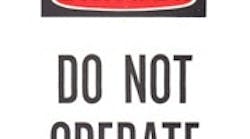For most machine and robot OEMs, safety circuits and sensors are a necessity. In the past, there have been two primary methods for implementing safety: safety relays and safety PLCs.
Safety relays work well in simple, small-scale applications, but can be cumbersome in larger or more complex systems. Safety PLCs can handle the largest and most difficult applications, but at substantial cost, particularly if the safety PLC is provided in addition to the main controller.
What many OEMs need is a mid-range solution, more capable than safety relays but less expensive than a safety PLC. Enter the safety controller, essentially a stripped-down version of the safety PLC, with sufficient features and I/O capacity to handle many OEM applications.
Mike Garrick, safety product specialist at Phoenix Contact (www.phoenixcon.com), describes a typical application for a safety controller: "A caged-in depalletizer might monitor devices such as light curtains, emergency stops and safety door interlock inputs," he says. "With the degree of danger involved, this type of application requires safety measures to be redundant using safety-rated components."
A light curtain prevents access to hazardous parts of many machines, Garrick adds, including depalletizers. "When the light curtain beams are broken, the machine will go into a safe state," he explains. "During a depalletizer's normal operation, however, the pallet must drive through the light curtain for unloading. In this case, the machine shouldn't power down into the safe state. With a safety controller such as our PSR-Trisafe, the muting of the light curtain is controlled by software for the proper amount of time to allow the pallet to pass."
A safety PLC isn't a cost-effective choice for low- to medium-I/O-point counts and low to medium design complexity, but a safety controller is well-suited for these types of applications, he says.
Another OEM upgraded to a safety controller, saving time and money. "A form/fill/seal packing equipment OEM has a current machine platform that's available in several variations with different options," relates Tony Rigoni, business development manager at Omron Scientific Technologies (www.sti.com). "Previously, each variation of its machine had a different configuration of safety components. Its low-end design had e-stops, door switches and safety relays. The deluxe models had more of the same, plus light curtains and safety mats, along with complex interlocking requirements."
Accounting for every variation, the OEM had more than 21 possible wiring diagrams just for its safety components, and estimated it cost several hundred dollars per machine just to wire and track all the different configurations. "To streamline, simplify and cut costs, this OEM decided to use a programmable safety controller from Omron STI on each machine," Rigoni explains. "The OEM simply wired all inputs to the safety controller and downloaded the appropriate controller software program. It reported cutting several hours of design and build time off of each machine."
A palletizer application claims hard number savings for a safety controller upgrade. "Recently, an OEM reevaluated the safety and safeguarding solutions for one of its robotic palletizers," says Mike Carlson, safety products marketing manager at Banner Engineering (www.bannerengineering.com). The original scheme included two safety light screens that would be muted as material passed into and out of the cell, three interlocked gates using magnetic switches, and several e-stop buttons. All the devices were monitored by several safety modules.
"Those safety modules included two safety light curtain muting modules at $322 each, three magnetic switch monitoring modules at $211 each, and one 4xNO output e-stop module for $195, making the total cost of the safety system $1,472," Carlson details. "Banner was called on to see if an alternate solution could be found at a lower cost. All of the safety modules were replaced with a single safety controller, and the cost of the safety system was reduced to $600, a savings of approximately 60%."





